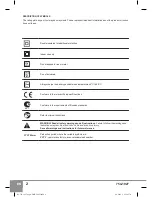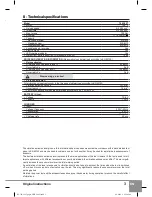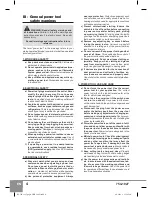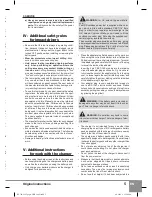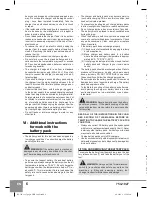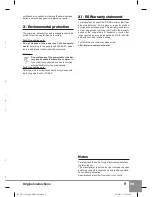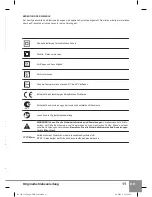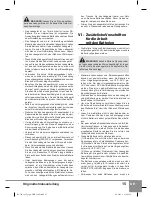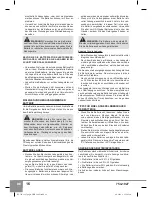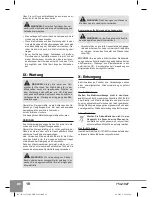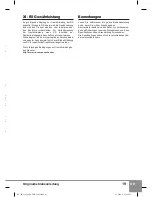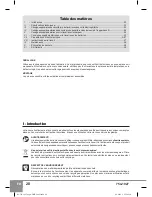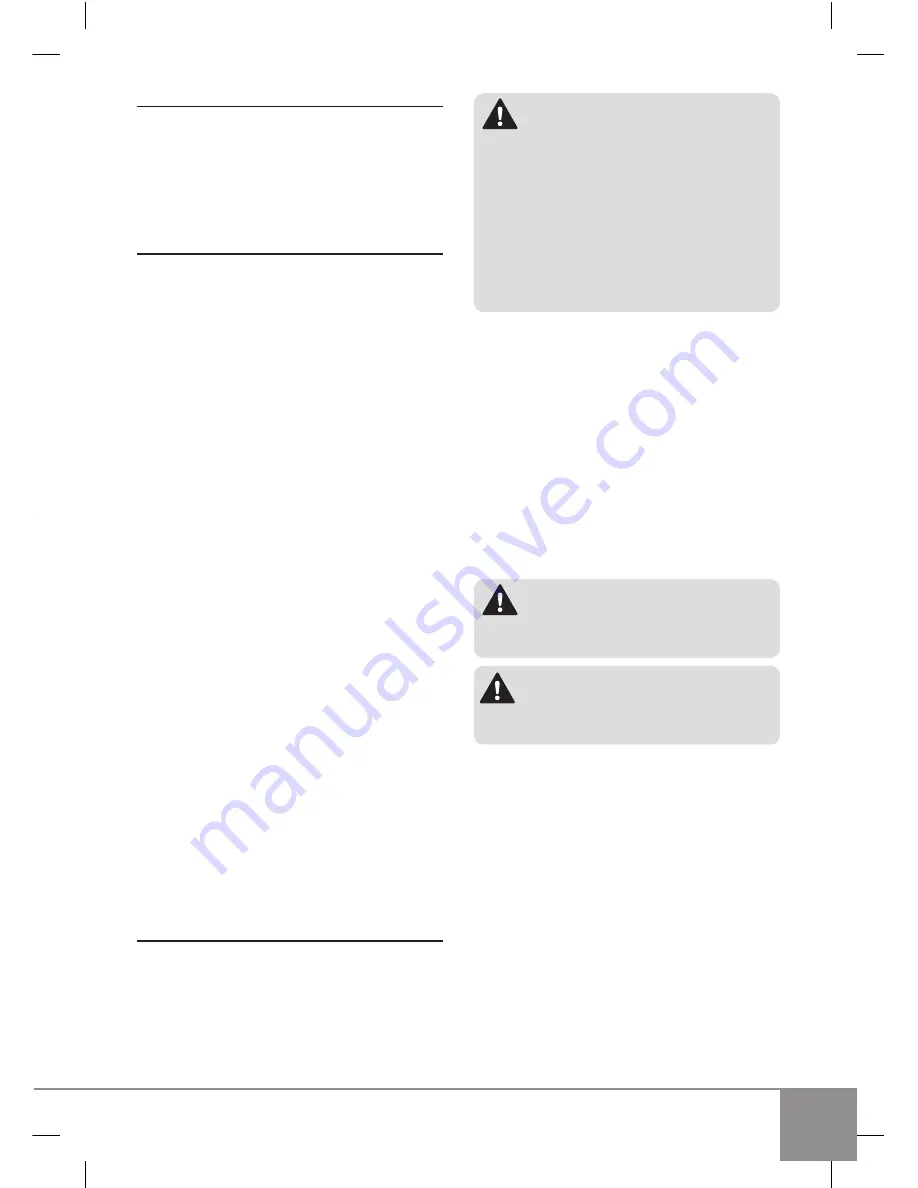
Original instructions
5
EN
wear eye protection.
Protective equipment such
as dust mask, non-skid safety shoes, hard hat, or
hearing protection used for appropriate conditions
will reduce personal injuries.
c) prevent unintentional starting. ensure the
switch is in the off-position before connecting
to power source and/or battery pack, picking
up or carrying the tool.
Carrying power tools with
your finger on the switch or energising power tools
that have the switch on invites accidents.
d) Remove any adjusting key or wrench before
turning the power tool on.
A wrench or a key left
attached to a rotating part of the power tool may
result in personal injury.
e) Do not overreach. keep proper footing and bal-
ance at all times.
This enables better control of
the power tool in unexpected situations.
f) Dress properly. Do not wear loose clothing or
jewellery. keep your hair, clothing and gloves
away from moving parts.
Loose clothes, jewel
-
lery or long hair can be caught in moving parts.
g) if devices are provided for the connection of
dust extraction and collection facilities, en-
sure these are connected and properly used.
Use of dust collection can reduce dust-related haz-
ards.
4. pOWeR tOOl Use anD caRe
a) Do not force the power tool. Use the correct
power tool for your application.
The correct
power tool will do the job better and safer at the
rate for which it was designed.
b) Do not use the power tool if the switch does
not turn it on and off.
Any power tool that can-
not be controlled with the switch is dangerous and
must be repaired.
c) Disconnect the plug from the power source
and/or the battery pack from the power tool
before making any adjustments, changing ac-
cessories, or storing power tools.
Such preven-
tive safety measures reduce the risk of starting the
power tool accidentally.
d) store idle power tools out of the reach of chil-
dren and do not allow persons unfamiliar with
the power tool or these instructions to operate
the power tool.
Power tools are dangerous in the
hands of untrained users.
e) maintain power tools. check for misalignment
or binding of moving parts, breakage of parts
and any other condition that may affect the
power tool’s operation. if damaged, have the
power tool repaired before use.
Many accidents
are caused by poorly maintained power tools.
f) keep cutting tools sharp and clean.
Properly
maintained cutting tools with sharp cutting edges
are less likely to bind and are easier to control.
g) Use the power tool, accessories and tool bits
etc. in accordance with these instructions, tak-
ing into account the working conditions and
the work to be performed.
Use of the power tool
for operations different from those intended could
result in a hazardous situation.
5. seRvice
a) Have your power tool serviced by a qualified
repair person using only identical replacement
parts.
This will ensure that the safety of the power
tool is maintained.
IV - Additional safety rules
for impact drivers
▪
Be aware that this tool is always in operating condi-
tion, because it does not have to be plugged into an
electrical outlet. Always set the trigger switch to the
locked OFF position when installing or removing the
battery pack.
▪
Wear ear protectors when impact drilling.
Expo-
sure to noise can cause hearing loss.
▪
Hold power tool by insulated gripping surfaces
only, when performing an operation where the
cutting accessory may contact hidden wiring or
its own cord.
Cutting accessory contacting a “live”
wire may make exposed metal parts of the power tool
“live” and could give the operator an electric shock.
▪
The tool must be used only for its prescribed purpose.
Any use other than those mentioned in this Manual
will be considered a case of misuse. The user and not
the manufacturer shall be liable for any damage or in-
jury resulting from such cases of misuse.
▪
To use this tool properly, you must observe the safety
regulations, the assembly instructions and the oper-
ating instructions to be found in this Manual. All per-
sons who use and service the machine have to be
acquainted with this Manual and must be informed
about its potential hazards. Children and frail people
must not use this tool. Children should be supervised
at all times if they are in the area in which the tool is
being used. It is also imperative that you observe the
accident prevention regulations in force in your area.
The same applies for general rules of occupational
health and safety.
▪
The manufacturer shall not be liable for any changes
made to the tool nor for any damage resulting from
such changes.
▪
Even when the tool is used as prescribed it is not pos-
sible to eliminate all residual risk factors. The following
hazards may arise in connection with the tool’s con-
struction and design:
▪
Damage to hearing if effective ear defenders are not
worn.
V - Additional instructions
for work with the charger
▪
Before using the charger, read all the instructions and
cautionary markings on the charger and battery pack
as well as the instructions on using the battery pack.
▪
Only charge your batteries indoors as the charger is
designed for indoor use only.
WaRning:
(For UK, Ireland, Cyprus or Malta
only):
Your RS cordless power tool is supplied with a char-
ger, which is fitted with a standard CEE 7/16” Euro
plug. In order for you to safely use this charger in the
UK, Ireland, Cyprus or Malta, you will need to fit the
enclosed converter plug. Not using the supplied con-
verter plug may invalidate the warranty.
The converter plug encapsulates an Euro plug, giving
a permanent/semi-permanent conversion to a British
plug. Please see instructions
(Fig. 3)
at the front of the
manual before fitting this converter plug.
▪
Place the adapter plug flat side down on the work sur-
face, using the correct screwdriver (either flat head or
Philips) unscrew the central retaining screw. Turn over
the adapter plug and carefully lift the cover of the plug
to reveal the inside of the adapter.
▪
Insert the 2 pin CEE 7/16 Euro plug into the retaining
clips of the adapter plug as shown on
Fig. 3
and care-
fully close the cover of the adapter plug. Turn the plug
over, to reveal again the central retaining screw and
carefully tighten the screw, making sure the two sides
of the adapter plug fit together.
▪
Your adapter plug is now complete and is ready to
use in a BS 1363 electric socket as shown. Please
note you should never remove and type of plug from a
socket by pulling the cable, you should always remove
by gripping the plug itself.
WaRning:
If the battery pack is cracked or
damaged in any other way, do not insert it in the char-
ger. There is a danger of electric shock.
WaRning:
Do not allow any liquid to come
into contact with the charger. There is a danger of elec-
tric shock.
▪
The charger is not intended for any use other than
charging the exact type of RS rechargeable battery
pack as supplied with the charger. Any other use may
result in the risk of fire or electric shock.
▪
The charger and battery packs supplied with it are
specifically designed to work together. Do not attempt
to charge the battery pack with any other charger than
the one supplied.
▪
Do not place any object on top of the charger as it
could cause overheating. Do not place the charger
near any heat source.
▪
Do not pull on the lead of the charger to disconnect it
from the power source.
▪
Make sure that the charger cable is positioned where
it will not be stepped on, tripped over or otherwise
subjected to damage or stress.
▪
Do not use an extension cord unless it is absolutely
necessary. The use of an improper extension cord
could cause the risk of fire or electric shock.
▪
Do not use the charger if it has been subjected to a
RS-754-1927-pages-GUR 10.8Li.indd 5
8.6.2012 г. 15:14:58 ч.




